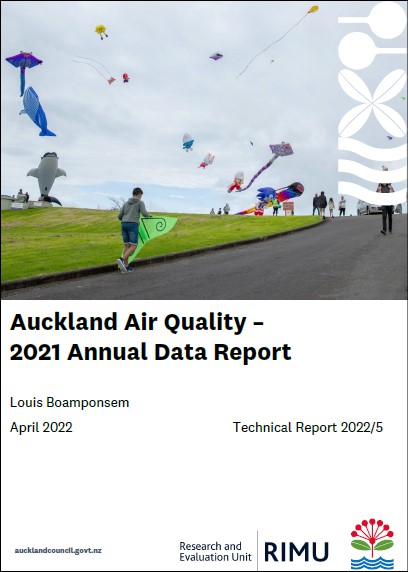Auckland air quality – 2021 annual data report
Author:
Louis BoamponsemSource:
Auckland Council Research and Evaluation Unit, RIMUPublication date:
2022Topics:
EnvironmentExecutive summary
Air pollution is the leading environmental risk factor worldwide. World Health Organization (WHO) estimates show that around seven million deaths are attributable to air pollution. People with pre-existing respiratory and heart conditions, diabetes, the young, and elderly people are particularly vulnerable to air pollution effects. Each year, air pollution causes more than 300 premature deaths in Auckland and results in increased numbers of reduced activity days and hospital visits, and higher usage of medications. It is estimated that the social cost of air pollution in Auckland is $1.07 billion per year. Air pollution can affect the atmosphere and climate directly through the warming and cooling properties of some pollutants.
Auckland sits on an isthmus between the Tasman Sea and the South Pacific Ocean. With no landmass close to the east or west of the city, there is a relatively clean and reliable airflow in Auckland, helping remove air pollutants emitted across the region. Despite this, some anthropogenic activities in Auckland create pollution levels that can exceed national and international standards and impact people’s health.
Transport, home heating, and industrial emissions are the main anthropogenic sources of air contaminants in Auckland. Auckland Council is responsible for the management of air quality in the region. The council is required to monitor air quality under the Resource Management Act 1991 and the National Environmental Standards for Air Quality (NESAQ). To achieve this, the council continuously collects air quality data to assess compliance and provide information to aid policy development and evaluation. The data the council collects enables us to quantify ambient air quality in the region and note spatial and temporal variations. Key air contaminants monitored in Auckland are particulate matter (PM10 and PM2.5), black carbon, carbon monoxide (CO), nitrogen dioxide (NO2), ozone (O3), sulphur dioxide (SO2), and volatile organic compounds.
Data and information from the Auckland air quality monitoring network is reported in multiple ways. Monthly reports are regularly published on the Knowledge Auckland website, www.knowledgeauckland.org.nz. Data is available on the RIMU Environmental Data Portal, www.environmentauckland.org.nz and technical reports are produced in specific reporting years. This is the annual data report for 2021 data and its assessment against the NESAQ, Auckland Unitary Plan air quality target, and the revised 2021 WHO air quality guidelines.
Key findings:
- No breach of national air quality standards occurred in 2021.
- Auckland’s air quality in 2021 slightly improved by 0.34% compared to the previous year. This improvement could be due to the COVID-19 restrictions.
- The average PM10 concentration of Auckland in 2021 increased by 1.3% compared to 2020 but did not exceed the new 2021 WHO air quality guideline of 15 μg/m3. Queen Street monitoring site exceeded the WHO annual guideline by 24%.
- The average PM2.5 concentration of Auckland in 2021 increased by 6.7% compared to 2020. This increase was over the 2021 WHO air quality guideline of 5 μg/m3. Auckland's target for 24-hour average PM2.5 concentration was exceeded on one occasion during winter at Pakuranga
- Overall, concentrations of particulate matter peak in the afternoon and night hours and mostly increase later in the week with the highest concentrations typically occurring on Wednesday to Friday.
- The annual mean NO2 concentration for Auckland in 2021 is the lowest recorded since 2006. The annual mean concentration significantly decreased by 16.7% compared to 2020. However, Auckland’s overall annual average NO2 concentration exceeded the 2021 WHO air quality guideline of 10 μg/m3. The WHO 24-hour guideline for NO2 was exceeded on many occasions at Queen Street, Customs Street, Khyber Pass Road, Takapuna and Penrose.
Auckland Council technical report, TR2022/5
April 2022
